[N. C., 1906, Pl. II. 1.]



[Cunningham, A., Coins of Alexander’s Successors in the East, 1873.
Von Sallet, A., Die Nachfolger Alexanders d. Gr. in Bactrien u. Indien in Z. f. N. 1879-83.
Gardner, P., Brit. Mus. Cat. Coins of the Greek and Scythic Kings of Bactria and India, 1886.
Rapson, E. J., Indian Coins in Bühler’s Grundriss der Indo-arischen Philologie, 1898, where
references to all anthoritative works are given.
Smith, V. A., Cat. of Coins in the Indian Museum, Calcutta, vol. i, 1906.]
During the Persian rule from the time of Darius, circ. B.C. 500, down to Alexander’s conquest, B.C. 327, there was constant intercourse between India and the West. The identification, however, of the coins current among the merchants in the far eastern satrapies and the Panjâb before the fall of the Persian empire, and subsequently down to the revolt of Diodotus and the establishment of an independent kingdom in Bactria, B.C. 250, must for the present remain more or less uncertain. Well authenticated finds from time to time will, however, it may be confi- dently anticipated, go far to settle the question.
It has been thought that during the Persian rule the siglos was the chief medium of exchange, and Professor Rapson (Countermarks on early Persian and Indian coins, in J. R. A. S., Oct. 1895) has drawn attention to the fact that the sigloi very frequently bear small punch-marks identical with those which occur on the square silver punch-marked coins current in Northern India.
Athenian tetradrachms of the ‘old style’ also penetrated into the countries north of the Indus, as is proved by the provenance of nu- merous specimens; and when the supply of these began to fail, they were copied with various modifications of type and symbol by native moneyers before the Macedonian conquest (B. V. Head, ‘Graeco-Bactrian and Graeco-Indian coins,’ Num. Chron., 1906, pp. 1-16). Next follows the introduction into Bactria of the gold double-daric, contemporaneously, as I think, with the occupation of that country by Alexander on the death of Darius. These coins, of the old Persian type though with Greek monograms and symbols in the field, were probably first issued at Babylon (see under Persia, supra, p. 828) by Mazaeus as Alexander's satrap, from the vast treasures which had fallen into the hands of the conqueror. Graeco-Bactrian or Graeco-Indian moneyers seem also to have struck less well-executed copies at local mints, chiefly, it may be assumed, for the payment of mercenary troops rather than for the needs of commerce. With the double darics I would associate the class of silver coins with the same obverse type and with an incuse reverse adorned with a strange un-Hellenic device (see supra, p. 829).
It was not, however, until Alexander’s culminating victory at the river Hydaspes over the Indian king Porus that any coins were issued in the far east in the conqueror’s own name. Perhaps the earliest of these is the following dekadrachm, which, as a numismatic record of a contemporary historical event, is of supreme interest :—
| Elephant walking r., carrying on his
back two warriors and pursued by a
horseman prancing, towards whom
they turn back, one of them attempt-
ing to pierce the horseman with a
backward and downward thrust of
his lance, while the other, with raised
r. arm, threatens to hurl at him a
javelin. [Num. Chron., 1906, Pl. I. 8.] |
ΑΒ (in mon. = Βασιλευς Αλεξανδρος (?))
Alexander standing to front, wearing
Persian helmet, cuirass, and cloak,
and holding in his extended r. a
thunderbolt (as in Apelles’ portrait) :
he rests with l. on spear, and from
his belt hangs a sword.
AR Attic Dekadrachm, 653 grs.
|
It must be noted that my description of the obverse of this piece differs in one essential point from previous descriptions of the same coin. I have described the lance as aimed by the elephant-rider backwards against the horseman instead of forwards by the horseman at the elephant-rider. We must wait for the discovery of a better-preserved specimen for a final decision as to which description is correct.
Meanwhile I would remark that in the whole range of Greek numis- matic art there is, so far as I am aware, no other instance of a coin-type designed, as I think, to represent pictorially a particular contempora- neous event, and, moreover, that the details of the type correspond so closely with the account, as handed down by Arrian (V. xviii. 9-11) of the retreat on his elephant of the wounded king Porus, after his defeat at the Hydaspes, and of his pursuit on horseback by Prince Taxiles, that I can hardly hesitate to regard this piece as a medal struck in the name of Alexander, and perhaps by Taxiles himself at his capital city Taxila, in commemoration of that episode.
Arrian’s account of what occurred is, briefly, as follows :—Porus, defeated and wounded in the shoulder, tries to escape capture on the back of his elephant. Taxiles, Prince of the Panjâb, is dispatched by Alexander in pursuit, to offer him terms of submission. Riding up to the elephant as close as it was safe so to do, he is recognized by Porus as his old enemy and rival. Porus thereupon twists himself round upon his beast and almost succeeds in spearing his pursuer with his lance; whereupon Taxiles wheels off and rides back to Alexander, who, anxious to take Porus alive, sends after him a more welcome ambassador.
The turning or twisting round of Porus on his elephant in order to spear his enemy—επιστρεψας ανηγετο ως ακοντισων—is rendered to the life on this remarkable medallion, and that it is by a Greek artist, unfami- liar with the anatomy of an elephant, may be inferred from the mistaken delineation of the hind-legs of the animal, the knees of which in nature bend forwards.
Returning from this medallion to the coins (properly so called), which I would attribute to north-west India during the transitional period between B.C. 326 and 306, when Seleucus assumed the title of king, we note that they belong not to the Attic standard which prevailed in Bactria, but to an ancient Indian standard, of which the drachm weighed 58 ½ grs., identical with, but doubtless of different origin from, the Rhodian or Phoenician standard (see Rapson, Indian coins in Bühler’s Grundriss, p. 2). These are as follows :—
| Head of Athena; behind, bunch of
grapes and [N. C., 1906, Pl. II. 1.] |
ΑΘΕ Owl; behind, olive-spray and
crescent. AR Didrachm 107.7 grs.
|
| Similar; no mon. [Ibid., Pl. II. 2.] | Similar, but in field AR Drachm 53.5 grs.
|
| Head of Athena; behind, bunch of grapes. [Ibid., Pl. II. 3.] | Eagle l., looking back.
AR Drachm 54 grs.
|
| Similar. [Ibid., Pl. II. 4.] | Eagle l., looking back; behind, vine-
branch with two bunches of grapes.
AR Drachm 51 grs.
|
| Id. [Ibid., Pl. II. 5.] | Id. AR Diobol 18 grs.
|
| Similar. [Ibid., Pl. II. 6.] | Eagle l., looking back; behind, caduceus
and vine-branch with two bunches of
grapes. AR Drachm 51.6 grs.
|
| Similar. [Ibid., Pl. II. 7.] | Eagle l., looking back; behind, mon. AR Drachm 54.9 grs.
|
The monogram on the last-mentioned coin may stand for Eudamus, who was commissioned by Alexander to administer the Indian satrapy as a colleague of Taxiles (Arrian, VI. xxvii. 2).
| Head of Zeus r., laur. [Ibid., Pl. II. 8.] | Eagle l., looking back; behind, vine-
branch with two bunches of grapes.
AR Diobol. 18.1 grs.
|
| Head of Zeus r., laur.; border of dots. [Ibid., Pl. II. 9.] |
ΑΛΕΞΑΝΔΡΟΥ Eagle r., on fulmen,
looking back; in field l., olive-spray
(as on coins of Athenian type); in field
r., Persian satrapal tiara with loose
flaps. AR Tetradrachm 222.5 grs.
|
| Id. [Imhoof, Monn. gr., Pl. D. 8.] | Similar, but club instead of olive-spray.
AR Tetradrachm 227 grs.
|
| Head of Alexander r., in lion-skin. [Z. f. N., vi, Pl. IV. 1.] |
ΑΛΕΞΑΝΔΡΟΥ Club and bow in case;
above, caduceus.
Æ Size .7 (square Indian fabric).
|
The above-described coins, with Athenian merging into Macedonian types, seem to have been followed by those which bear the name of Sophytes. They are of the same Indian standard.
Sophytes, circ. B.C. 316-306, a prince, apparently independent, who ruled over a kingdom in the north of the Panjâb.
| Head of Sophytes in Athenian helmet
with cheek-piece, bound with olive. [B. M. Guide, Pl. 28. 17.] |
ΣΩΦΥΤΟΥ Cock; behind, caduceus.
AR Drachm 58.2 grs
|
| Head of Athena in Corinthian helmet. [Z. f. N., xxiv, Pl. IV. 7.] |
Similar to preceding.
AR Trihemiobol 13.5 grs.
|
| Head of Zeus r., laur., as above. [Num. Chron., 1906, Pl. II. 11.] |
ΒΑΣΙΛΕΩΣ ΣΕΛΕΥΚΟΥ ΑΝΤΙΟ-
ΧΟΥ Athena fighting in quadriga of
elephants r.
AR Tetradrachm 214.5 grs.
|
| Similar. [Ibid., Pl. II. 12.] | Similar, hut Athena in biga of elephants.
AR Drachm 53.2 grs.
|
| Id. [Ibid., Pl. II. 13.] | Id. AR Hemidrachm 25.2 grs.
|
| Similar. [Ibid., Pl. II. 14.] | ΒΑΣΙΛΕΩΝ ΣΕΛΕΥΚΟΥ ΚΑΙ ΑΝ-
ΤΙΟΧΟΥ Similar.
AR Drachm 54.6 grs.
|
These exceptional coins are of Indian provenance and of the Indian standard. They are all later than B.C. 306, the year in which Seleucus assumed the title Βασιλευς, and the last of them must be as late as B.C. 293, when the title ‘King of the East’ was bestowed upon Antiochus by his father (see supra, pp. 757 ff.). They probably belong to the time of the invasion of India by Seleucus, for after his treaty of peace with Sandracottus and his cession to him of the Panjâb, &c., Seleucid coins would not be struck in India.
From this time down to the revolt of Diodotus from Antiochus II and the establishment by him of the independent kingdom of Bactria, it is difficult to distinguish among the Seleucid coins those which were issued in the far eastern provinces from the rest, as they are all of the Attic standard. Provenance and fabric are the only guides; see supra, pp. 757 ff.
For about a century (B.C. 250-150) the coins of the independent Bactrian kingdom follow the Attic standard and are purely Hellenic in character, the portraits of the kings are strikingly realistic, and the figures of the various Greek divinities which form the reverse types betray the skilful hand of the Greek artist. Greek civilization in Bactria was overwhelmed towards the end of the first half of the second century B.C. by hordes of Scythic invaders, called Sse or Sek (Sakas) by the Chinese historians of the period; and the Greek coinage was superseded by barbarous imitations (Num. Chron., 1889, p. 301).
But in the meantime an extension of Greek power from Bactria into India had again taken place, in consequence of the conquests of Euthy- demus (circ. B.C. 206) and his son Demetrius, and a new series of coins, which may conveniently be called Graeco-Indian, makes its appearance. This coinage is no longer purely Greek in character, but is influenced in a marked degree by the native Indian form of coinage, oblong or square
While the succession of the kings in the Bactrian series may be fixed with approximate certainty, in the Graeco-Indian series every- thing is uncertain—the determination of the different dynasties, their dates and their locality, and the order of succession. That there were several families of Greek princes ruling contemporaneously in India during the second and first centuries B.C. is unquestionable; and it is possible that some of these may date from the time of Alexander, since ‘Greeks’ (Yonas, ‘Ιωνες) are mentioned among the powers of Northern India in Asoka’s edicts (circ. B.C. 250) about half a century before the invasion of the Bactrian Greeks (B. M. Cat., Coins of the Andhra Dynasty, &c., p. xcvii). At present almost the only definite information which we possess as to the history of these Graeco-Indian kingdoms is afforded by the coins of their Scythic conquerors who imitated their types. Thus the transference of various districts in Northern India from Greek to Scythic dominion is shown by a comparison of the types of Demetrius, Eucratides, Strato I and II, and Hermaeus, with those of Maues, Kusula Patika, Ranjubula and Kujula Kadphises respectively (ibid., p. ci; Corolla Numismatica, p. 257; Indian Coins, § 29).
Since, therefore, the arrangement of the Graeco-Indian series is at present uncertain, I have in the following pages adopted the classification in which, from analogy of types, style, and epigraphy, the coins have been arranged in the British Museum Cabinet by Professor Gardner.
The student who would pursue the subject further may be referred to the works mentioned at the head of this section, p. 832.
Diodotus appears to have revolted from Antiochus II, or to have been acknowledged as king by him about B.C. 250. See supra, p. 760.

Inscr., ΒΑΣΙΛΕΩΣ ΔΙΟΔΟΤΟΥ. AV and AR Zeus hurling fulmen, Eagle at his feet (Fig. 364); Æ Artemis running with torch, dog beside her (B. M. Cat., Pl. I. 9).
Demetrius, son of Euthydemus I, extended his dominions into India. AR Tetradr., dr., and obol, ΒΑΣΙΛΕΩΣ ΔΗΜΗΤΡΙΟΥ, Head of King diademed, rev. Athena standing, and more frequently King’s head in Elephant-skin, rev. Herakles standing crowning himself (Fig. 365).
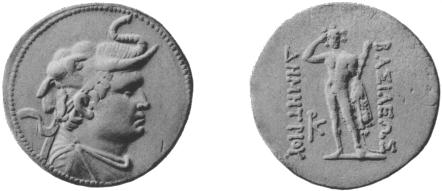
Æ Head of Herakles, rev. Radiate Artemis standing; Shield, rev. Trident; Elephant’s head, rev. Caduceus; also square Æ ΒΑΣΙΛΕΩΣ ΑΝΙΚΗΤΟΥ ΔΗΜΗΤΡΙΟΥ, rev. Fulmen, and Indian Kharoṣṭhī inscr. (B. M. Cat., Pl. II. 9-12; III. 1, 2; XXX. 1-3).
Euthydemus II, son of Demetrius. AR Tetradr. and dr., ΒΑΣΙΛΕΩΣ ΕΥΘΥΔΗΜΟΥ, Boyish head of King, rev. Herakles facing (Fig. 366);
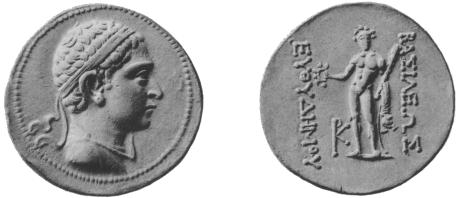
Nickel and Æ, Head of Apollo, rev. Tripod; Bearded head of Herakles, rev. Horse (B. M. Cat., Pl. III. 3-7).
Pantaleon, contemporary with or successor of Euthydemus II. AR Tetradr., ΒΑΣΙΛΕΩΣ ΠΑΝΤΑΛΕΟΝΤΟΣ, Zeus enthroned holding statuette of Hekate (B. M. Cat., Pl. XXX. 4); Æ square, Greek and Indian Brāhmī inscrr., Dancing figure, rev. Lion (op. cit., Pl. III. 9); Nickel and Æ circular, Head of Dionysos, rev. Panther (op. cit., Pl. III. 8).
Agathocles, contemporary with or successor of Pantaleon. AR Tetradrs. in commemoration of his predecessors, (i) of Alexander the Great, ΑΛΕΞΑΝΔΡΟΥ ΤΟΥ ΦΙΛΙΠΠΟΥ, Head of Alexander in lion-skin, rev.
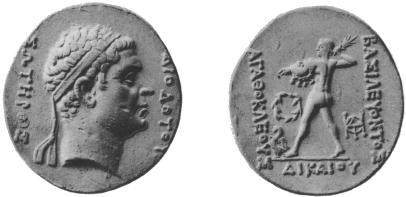
ΒΑΣΙΛΕΥΟΝΤΟΣ ΑΓΑΘΟΚΛΕΟΥΣ ΔΙΚΑΙΟΥ, Zeus aëtophoros en- throned (Num. Chron., 1880, Pl. X. 1); (ii) of Antiochus II (?), ΑΝ- ΤΙΟΧΟΥ ΝΙΚΑΤΟΡΟΣ, rev. same inscr. as last, Zeus l. wielding fulmen (B. M. Cat., Pl. XXX. 5); (iii) of Diodotus, ΔΙΟΔΟΤΟΥΣΩΤΗΡΟΣ, rev. as last (Fig. 367); (iv) of Euthydemus, ΕΥΘΥΔΗΜΟΥ ΘΕΟΥ, rev. same inscr. as last, Herakles seated on rock (B. M. Cat., Pl. IV. 3). Also AR Tetradr., dr., and ½ dr., with name of Agathocles only, ΒΑΣΙΛΕΩΣ ΑΓΑΘΟΚΛΕΟΥΣ, Zeus standing holding Hekate (op. cit., Pl. IV. 4, 5). Nickel and Æ (circular), Bust of Dionysos, rev. Panther (op. cit., Pl. IV. 6-8). Square Æ, with bilingual (Greek and Indian Kharoṣṭhī) inscrr., Dancing figure, rev. Lion, &c. (op. cit., Pl. IV. 9); Æ with Kharoṣṭhī inscrr., Tope, rev. Sacred tree (op. cit., Pl. IV. 10).
Antimachus, contemporary with Agathocles. AR Tetradr. in com- memoration of his ancestors Diodotus and Euthydemus, ΔΙΟΔΟΤΟΥ ΣΩΤΗΡΟΣ, rev. ΒΑΣΙΛΕΥΟΝΤΟΣ ΑΝΤΙΜΑΧΟΥ ΘΕΟΥ, Zeus l. wield- ing fulmen (B. M. Cat., Pl. XXX. 6); ΕΥΘΥΔΗΜΟΥ ΘΕΟΥ, rev.
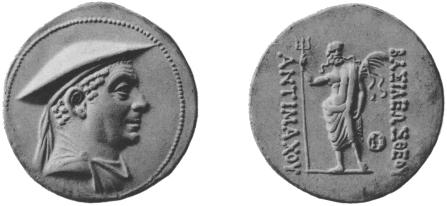
ΒΑΣΙΛΕΥΟΝΤΟΣ ΑΝΤΙΜΑΧΟΥ ΘΕΟΥ Herakles seated on rock. Also AR Tetradr., dr., ½ dr., and obol, Head of Antimachus in broad Macedonian kausia, rev. ΒΑΣΙΛΕΩΣ ΘΕΟΥ ΑΝΤΙΜΑΧΟΥ, Poseidon standing holding trident and palm (Fig. 368); Æ Elephant, rev. Nike on Prow (B. M. Cat., Pl. XXX. 7).
Eucratides, king of Bactria and India, circ. B.C. 200-150. AV Medal- lion of 20 staters’ weight, the largest ancient gold coin in existence, now in the Bibliothèque Nationale at Paris, obv. Bust of king with helmet adorned with bull’s horn and ear, rev. ΒΑΣΙΛΕΩΣ ΜΕΓΑΛΟΥ ΕΥΚΡΑ- ΤΙΔΟΥ, The Dioskuri on horseback (Rev. Num., 1867, p. 382). Also AV
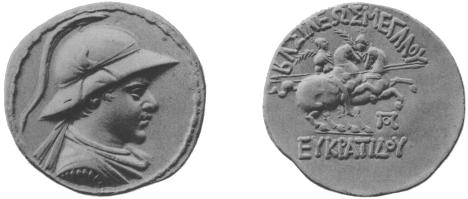
or helmeted, rev. The Dioskuri on horseback (Fig. 369), or Apollo standing. AR Obols, Pilei of the Dioskuri. Of the coins of this king there are numerous barbarous imitations. There is also a ½ dr. with a bilingual (Greek and Kharoṣṭhī) inscription, type—Dioskuri standing (B. M. Cat., Pl. XXX. 9); Æ circular with Greek, and square with bilingual inscr., obv. Head of king or head of Apollo, rev. Horse; Horseman; The Dioskuri; The Pilei of the Dioskuri; Nike; Zeus seated (B. M. Cat., Pl. VI. 1-8; XXX. 10-12).
Eucratides with Heliocles and Laodice.
| ΒΑΣΙΛΕΥΣ ΜΕΓΑΣ ΕΥΚΡΑΤΙ-
ΔΗΣ Helmeted bust of Eucratides. [B. M. Cat., Pl. VI. 9, 10.] |
ΗΛΙΟΚΛΕΟΥΣ ΚΑΙ ΛΑΟΔΙΚΗΣ
Busts of Heliocles bare and Laodice
diademed. AR Tetradr. and dr.
|
In all probability the word υιος is to be understood as the connecting link between the obverse and reverse legends of these coins, the in- ference being that Heliocles and Laodice were the father and mother of Eucratides. Von Sallet, however, conjectures that Eucratides caused these pieces to be struck on the occasion of a marriage of a son of his, by name Heliocles, with a princess named Laodice, who may have been a grand-daughter of Antiochus III of Syria.
Plato, contemporary with Eucratides. Unique dated tetradrachm in the British Museum. Bust of king with helmet resembling that of Eucratides, rev. ΒΑΣΙΛΕΩΣ ΕΠΙΦΑΝΟΥΣ ΠΛΑΤΩΝΟΣ, Helios in quadriga facing. Date, [Ρ]ΜΖ, 147 of the Seleucid era = B.C. 166 (B. M. Cat., Pl. VI. 11).
Heliocles, circ. B.C. 150-125, son and successor of Eucratides, probably the last Greek king who reigned over the country to the north of the Indian Caucasus.
| Bust of Heliocles, diademed. [Fig. 370, and B. M. Cat., Pl. XXXI. 1.] |
ΒΑΣΙΛΕΩΣ ΗΛΙΟΚΛΕΟΥΣ ΔΙ-
ΚΑΙΟΥ Zeus standing, holding ful-
men and sceptre, or seated, holding
Nike and sceptre. AR Tetradr.
AR Dr. |
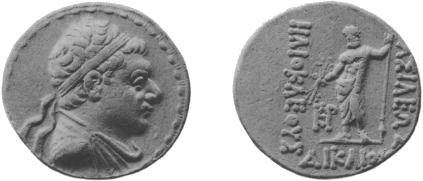
The bronze coins are usually barbarous. Rev. types—Zeus standing; Horse. In this king’s reign, or in that of a second Heliocles, the Attic standard was superseded by a native silver standard, of which the stater weighs 152 grs. and the ¼ stater 38 grs. (see supra, p. 836).
| ΒΑΣΙΛΕΩΣ ΔΙΚΑΙΟΥ ΗΛΙΟ- ΚΛΕΟΥΣ Bust of Heliocles. | Kharoṣṭhī inscr., Zeus standing, as
above. [B. M. Cat., Pl. VII. 5, 6.].
AR 146 and 34 grs.
|
The bronze coins are square with bilingual legends, rev. Elephant or Indian bull (B. M. Cat., Pl. VII. 7, 8).
Antialcidas, circ. B.C. 150. AR Attic tetradr. and Indian quarter staters, the latter bilingual.
| Bust of king, diademed. [B. M. Cat., Pl. VII. 9.] |
ΒΑΣΙΛΕΩΣ ΝΙΚΗΦΟΡΟΥ ΑΝΤΙ-
ΑΛΚΙΔΟΥ Zeus Nikephoros en-
throned, with forepart of elephant
raising his trunk to Nike. AR Tetradr.
|
| Id., king sometimes helmeted or wear- ing kausia. | Id., but elephant in various positions.
AR Indian ¼ stater.
|
Circular and square bilingual Æ; Bust of Zeus, rev. Pilei of the Dios- kuri; or Bust of King, rev. Elephant (B. M. Cat., Pl. VIII. 1-4).
Antialcidas and Lysias. Bilingual square Æ, obv. ΒΑΣΙΛΕΩΣ ΑΝΙ- ΚΗΤΟΥ ΛΥΣΙΟΥ, Bust of bearded Herakles, rev. Kharoṣṭhī inscr. con- taining name of Antialcidas. Type—Pilei of the Dioskuri (Bodleian Library) (B. M. Cat., Pl. XXXI. 2).
Theophilus. Bilingual AR ¼ staters of Indian wt., ΒΑΣΙΛΕΩΣ ΔΙ- ΚΑΙΟΥ ⊟ΕΟΦΙΛΟΥ, Bust diademed, rev. Herakles crowning himself. Æ square—Bust of Herakles, rev. Cornucopiae (B. M. Cat., Pl. XXXI. 3, 4); Bust of king, rev. Club (Jour. As. Soc. Bengal, 1897, p. 1).
Lysias, circ. B.C. 150. Indian standard, ¼ stater, ΒΑΣΙΛΕΩΣ ΑΝΙΚΗΤΟΥ ΛΥΣΙΟΥ, Bust diademed, or in elephant-skin, rev. Kharoṣṭhī inscr., Herakles crowning himself.
Circular and square Æ, Bust of bearded Herakles, rev. Elephant (B. M. Cat., Pl. VIII. 5-9).
Diomedes. Bilingual AR staters and quarter staters, ΒΑΣΙΛΕΩΣ ΣΩΤΗΡΟΣ ΔΙΟΜΗΔΟΥ, rev. The Dioskuri standing or riding. Æ The Dioskuri standing, rev. Humped bull (Num. Chron., 1887, p. 182, Pl. VII. 2, 3; B. M. Cat., Pl. VIII. 10-14).
Apollodotus. There may have been two kings of this name. The coins are always bilingual and follow the Indian standard. AR ¼ staters, round or square, ΒΑΣΙΛΕΩΣ ΑΠΟΛΛΟΔΟΤΟΥ ΣΩΤΗΡΟΣ, Elephant, rev. Humped bull; and square Æ Apollo standing, rev. Tripod (B. M. Cat., Pl. IX. 8-13). Later style (perhaps Apollodotus II), AR staters, ΑΠΟΛΛΟΔΟΤΟΥ ΒΑΣΙΛΕΩΣ ΜΕΓΑΛΟΥ ΣΩΤΗΡΟΣ ΚΑΙ ΦΙΛΟΠΑ- ΤΟΡΟΣ, rev. Athena fighting (Fig. 371). ¼ staters similar, but without the word ΜΕΓΑΛΟΥ, others with ΒΑΣΙΛΕΩΣ ΣΩΤΗΡΟΣ ΑΠΟΛΛΟ-
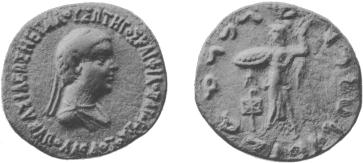
ΔΟΤΟΥ. Æ circular and square, Apollo standing or seated, rev. Tripod; ΒΑΣΙΛΕΩΣ ΣΩΤΗΡΟΣ ΚΑΙ ΦΙΛΟΠΑΤΟΡΟΣ ΑΠΟΛΛΟΔΟΤΟΥ, Similar (B. M. Cat., Pl. X. 1-9).
Agathocleia, as Queen regent during the minority of her son Strato I. She was contemporary with Heliocles.
AR stater. Busts of Agathocleia and Strato I, ΒΑΣΙΛΕΩΣ ΣΩΤΗΡΟΣ ΣΤΡΑΤΩΝΟΣ ΚΑΙ ΑΓΑΘΟΚΛΕΙΑΣ; rev. Fighting Athena, Kharoṣṭhī inscr. with name of Strato I (Num. Chron., 1887, p. 183, Pl. VII. 7); AR, ¼ stater, Bust of Agathocleia, ΒΑΣΙΛΙΣΣΗΣ ΘΕΟΤΡΟΓΙΟΥ ΑΓΑΘΟ- ΚΛΕΙΑΣ, rev. Warrior king, Kharoṣṭhī inscr. with name of Strato I (Corolla Num., p. 248, Pl. XII. 4).
AE. Bust of Agathocleia (previously supposed to be ‘Apollo with hair in queue’, B. M. Cat., p. 41), ΒΑΣΙΛΕΩΣ ΕΠΙΦΑΝΟΥΣ ΣΩΤΗΡΟΣ ΣΤΡΑΤΩΝΟΣ, rev. Bow and quiver, inscr. in Kharoṣṭhī characters (B. M. Cat., Pl. XI. 2).
Strato I, Soter, a contemporary of Heliocles. Bilingual AR staters and ¼ staters of Indian wt., and Æ ΒΑΣΙΛΕΩΣ ΕΠΙΦΑΝΟΥΣ (or ΔΙΚΑΙΟΥ) ΣΩΤΗΡΟΣ ΣΤΡΑΤΩΝΟΣ, Bust helmeted or diademed, rev. Athena fighting (B. M. Cat., Pl. X. 10-13; XI. 1; XXXI. 6). Square Æ Bust of Herakles, rev. Nike; Apollo standing, rev. Tripod (B. M. Cat., Pl. XI. 3-5).
Strato I, Soter, reigning conjointly with his grandson Strato II, Philopator. The relationship is certain from the Kharoṣṭhī inscr; the Greek inscr. is imperfect.
Bilingual AR ¼ staters of Indian weight and coins of lead, ΒΑΣΙΛΕΩΣ
Menander, circ. B.C. 160-140, is mentioned by Strabo (xi. 11. 1) as having extended his sway as far east as the Isamus (a branch of the Ganges, perhaps beyond the Jumna). AV stater, wt. 130 grs., unin- scribed, obv. Helmeted bust, rev. Owl; fillet border on both sides (Brit. Mus.). Bilingual AR staters and ¼ staters of Indian weight, ΒΑΣΙ- ΛΕΩΣ ΣΩΤΗΡΟΣ ΜΕΝΑΝΔΡΟΥ. Usual types—Bust diademed or helmeted, rev. Athena fighting; obv. Head of Athena, rev. Owl. Square Æ, obv. Bust of king, rev. Athena fighting; obv. Bust of Athena, rev. Prancing horse, Nike, Shield, Owl; obv. Bull’s head, rev. Tripod; obv. Elephant’s head, rev. Club; obv. Wheel, rev. Palm; obv. Young male head, Humped camel, Elephant. Boar’s head, rev. Dolphin. Bull’s head, Elephant-goad, Palm-branch. Also square Æ, with ΒΑΣΙΛΕΩΣ ΔΙ- ΚΑΙΟΥ ΜΕΝΑΝΔΡΟΥ, obv. Athena standing, rev. Lion (B. M. Cat., Pl. XI. 7-13; XII. 1-7; XXXI. 8-12).
Epander. Bilingual AR ¼ staters of Indian weight, ΒΑΣΙΛΕΩΣ ΝΙΚΗ- ΦΟΡΟΥ ΕΠΑΝΔΡΟΥ, Diademed bust, rev. Fighting Athena. Square Æ, Nike stephanephoros, rev. Humped bull (B. M. Cat., Pl. XXXI. 13 and XII. 8).
Dionysius. Bilingual AR ¼ staters of Indian weight, ΒΑΣΙΛΕΩΣ ΣΩΤΗΡΟΣ ΔΙΟΝΥΣΙΟΥ, Bust of king diademed, rev. Fighting Athena. Square Æ, Apollo standing, rev. Tripod; Royal diadem (B. M. Cat., Pl. XII. 9; XXXI. 14).
Zoilus. Bilingual AR ¼ staters of Indian weight, ΒΑΣΙΛΕΩΣ ΔΙΚΑΙΟΥ (or ΣΩΤΗΡΟΣ) ΖΩΙΛΟΥ, Bust of king diademed, rev. Herakles standing or Athena fighting.
Circular and square Æ, obv. Apollo standing, rev. Tripod; obv. Head of Herakles, rev. Bow and bow-case within ivy-wreath (B. M. Cat., Pl. XII. 10-13; XXXII. 1, 2).
Apollophanes. Bilingual AR ¼ staters of Indian weight, ΒΑΣΙΛΕΩΣ ΣΩΤΗΡΟΣ ΑΠΟΛΛΟΦΑΝΟΥ (sic), Bust helmeted(?), rev. Athena fighting (B. M. Cat., Pl. XIII. 1).
Artemidorus. Bilingual AR staters and ¼ staters of Indian weight, ΒΑΣΙΛΕΩΣ ΑΝΙΚΗΤΟΥ ΑΡΤΕΜΙΔΩΡΟΥ, Bust diademed or helmeted, rev. Artemis shooting with bow (type parlant); Nike stephanephoros (B. M. Cat., Pl. XXXII. 3-5).
Square Æ, Artemis standing facing drawing arrow from quiver, rev. Humped bull (B. M. Cat., Pl. XIII. 2); obv. similar, rev. Lion (B. M., unpublished).
Antimachus II (Nikephoros). Bilingual AR ¼ staters of Indian weight, ΒΑΣΙΛΕΩΣ ΝΙΚΗΦΟΡΟΥ ΑΝΤΙΜΑΧΟΥ, Nike stephanephoros, rev. King on horseback.
Square Æ, obv. Aegis, rev. Wreath and Palm (B. M. Cat., Pl. XIII. 3, 4).
Nicias. Bilingual AR ¼ staters of Indian weight, ΒΑΣΙΛΕΩΣ ΣΩΤΗ- ΡΟΣ ΝΙΚΙΟΥ. Bust diademed, rev. Figure standing holding palm (B. M. Cat., Pl. XXX II. 6).
Square Æ, obv. Bust diademed, rev. King on horseback or Anchor with dolphin twined round it (B. M. Cat., Pl. XIII. 11, 12).
Hippostratus. Bilingual AR staters and ¼ staters of Indian weight, ΒΑΣΙΛΕΩΣ ΣΩΤΗΡΟΣ ΙΠΠΟΣΤΡΑΤΟΥ, Bust diademed, rev. Tyche or City standing. Others, often with additional title, ΜΕΓΑΛΟΥ, rev. King on horseback (B. M. Cat., Pl. XIV. 1-5).
Square Æ, obv. Triton holding dolphin and rudder, rev. Turreted female figure holding palm; obv. Apollo standing, rev. Tripod; obv. Figure enthroned facing, rev. Horse (B. M. Cat., Pl. XIV. 6-8).
Amyntas. Bilingual AR staters and ¼ staters of Indian weight, ΒΑΣΙ- ΛΕΩΣ ΝΙΚΑΤΟΡΟΣ ΑΜΥΝΤΟΥ, Bust helmeted, diademed, wearing kausia, or bare, rev. Athena fighting or Zeus Nikephoros enthroned facing (B. M. Cat., Pl. XIV. 9, 10).
Square Æ Bust of bearded deity radiate, wearing Persian tiara, rev. Athena standing (B. M. Cat., Pl. XIV. 11).
Peucolaus. Bilingual Æ square, ΒΑΣΙΛΕΩΣ ΔΙΚ ΑΙΟΥ ΚΑΙ ΣΩΤΗ- ΡΟΣ ΠΕΥΚΟΛΑΟΥ, Artemis, rev. A City-Tyche, in l. hand cornucopiae (B. M.; cf. Num. Chron., 1896, p. 269).
Polyxenus. Bilingual Æ square, ΒΑΣΙΛΕΩΣ ΕΠΙΦΑΝΟΥ (sic) ΣΩΤΗΡΟΣ ΠΟΛVΞΕΝΟΥ, Bust helmeted, rev. Aegis (Num. Chron., 1896, p. 269).
Telephus. Bilingual AR ¼ staters of Indian weight, ΒΑΣΙΛΩΣ ΕΥΕΡ- ΓΕΤΟΥ ΤΗΛΕΦΟΥ, Giant Skythes (?) serpent-footed, holding hammer in each hand, rev. Helios radiate and male figure wearing wreath or horned, standing facing (B. M. Cat., Pl. XXXII. 7). Æ square, Zeus enthroned, rev. Seated male figure (B. M.).
Hermaeus. Bilingual AR staters and ¼ staters of Indian weight, ΒΑΣΙ- ΛΕΩΣ ΣΩΤΗΡΟΣ ΕΡΜΑΙΟΥ, Bust diademed or helmeted, or King on horseback, rev. Zeus enthroned facing (Fig. 372). Square and circular Æ
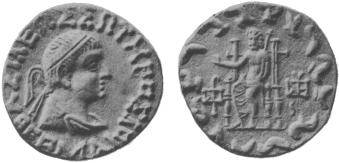
The coins of this king are imitated by the non-Greek king Kadphises, with the legend ΣΤΗΡΟΣΣΥ ΕΡΜΑΙΟΥ for ΣΩΤΗΡΟΣ ΕΡΜΑΙΟΥ. The first word, though in form similar to the Greek ΣΩΤΗΡΟΣ which it replaces, is probably an Indian title (Jour. Royal As. Soc., 1897, p. 319). Some of these imitations have Nike on the reverse (B. M. Cat., Pl. XXXII. 8).
Hermaeus and Calliope. Bilingual AR ¼ staters of Indian weight, ΒΑΣΙΛΕΩΣ ΣΩΤΗΡΟΣ ΕΡΜΑΙΟΥ ΚΑΙ ΚΑΛΛΙΟΠΗΣ, Busts of King and Queen diademed, rev. King on horseback (B. M. Cat., Pl. XV. 9, 10).
Epigraphy. The Indian inscriptions on the reverses of the above- described coins are of two kinds, (α) Brāhmī, which occurs only on the coins of Pantaleon and Agathocles, and (β) Kharoṣṭhī on those of all the other monarchs. The legend almost always begins with the word
The series of kings bearing Greek names comes to an end with Hermaeus, who probably reigned in the course of the last half-century before the Christian era. The Greek character in a modified form continued, however, to be used on the coins of the conquering Kushana kings, Kadphises I (with types of Hermaeus), Kadaphes, Kadphises II, Kanishka (ΚΑΝΗΚΙ) (A.D. 78-106 [1]), Huvishka (ΟΟΗΡΚΙ) (circ. A.D. 111-129), and Vāsudeva (ΒΑΖΟΑΗΟ sic) (A.D. 152-176), for more
1 The Saka era, starting from A.D. 78, probably commences from the date of the estab- lishment of the Saka empire in India by Kanishka.
This varied pantheon no doubt reflects the diversity of faith which
was professed in the different provinces of the great Kushana empire.
The Greek settlements in India, the Yavanas or Yonas (‘Ιωνες) of ancient
Indian literature and inscriptions, continued to strike coins with the
figures of Helios (ΗΛΙΟC), Selene (CΑΛΗΝΗ), Hephaestos (ΗΦΑΙCΤΟC),
Herakles (ΗΡΑΚΙΛΟ), or Sarapis (CΑΡΑΠΟ), while the Persian and
Scythic invaders, as well as the native Indian communities who had
adopted the use of the Greek alphabet, represented on their coins their
own divinities with the names expressed in Greek characters as :—
ΑΘ![]() Ο. Α
Ο. Α![]() ΑЄΙΧ
ΑЄΙΧ![]() Ο, ΛΡΟΟΑCΠΟ (sic), ΜΑΝΑΟΒΑΓΟ, ΜΑΟ, ΜΕΙΡΟ,
ΜΟΖΔΟΑΝΟ, ΟΑΝΙΝΔΑ, ΟΡΛΑΓΝΟ,
Ο, ΛΡΟΟΑCΠΟ (sic), ΜΑΝΑΟΒΑΓΟ, ΜΑΟ, ΜΕΙΡΟ,
ΜΟΖΔΟΑΝΟ, ΟΑΝΙΝΔΑ, ΟΡΛΑΓΝΟ, ![]() ΑΟΡΗΟΡΟ, ΦΑΡΡΟ (Persian),
ΝΑΝΑΙΑ, ΝΑΝΑ, or ΝΑΝΑ
ΑΟΡΗΟΡΟ, ΦΑΡΡΟ (Persian),
ΝΑΝΑΙΑ, ΝΑΝΑ, or ΝΑΝΑ![]() ΑΟ, and ΑΡΔΟΧ
ΑΟ, and ΑΡΔΟΧ![]() Ο (Scythic), ΒΙΖΑΓΟ,
ΒΟΔΔΟ or ΒΟΥΔΔΟ (Buddha), ΜΑΑCΗΝΟ, ΟΑΔΟ, ΟΗ
Ο (Scythic), ΒΙΖΑΓΟ,
ΒΟΔΔΟ or ΒΟΥΔΔΟ (Buddha), ΜΑΑCΗΝΟ, ΟΑΔΟ, ΟΗ![]() Ο, CΚΑΝΔΟ
ΚΟΜΑΡΟ (Indian).
Ο, CΚΑΝΔΟ
ΚΟΜΑΡΟ (Indian).